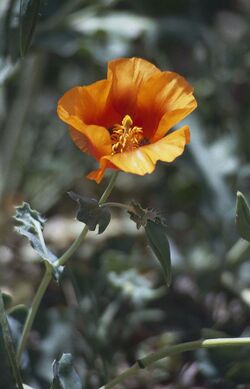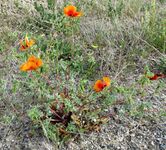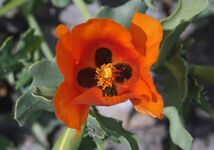Biology:Glaucium grandiflorum
| Glaucium grandiflorum | |
|---|---|

| |
| Scientific classification | |
| Kingdom: | Plantae |
| Clade: | Tracheophytes |
| Clade: | Angiosperms |
| Clade: | Eudicots |
| Order: | Ranunculales |
| Family: | Papaveraceae |
| Genus: | Glaucium |
| Species: | G. grandiflorum
|
| Binomial name | |
| Glaucium grandiflorum Boiss. & A.Huet
| |
| Synonyms[1] | |
| |
Glaucium grandiflorum, the great-flowered horned poppy, is a species of flowering plant in the horned poppy genus which is native to the Middle East.
Description
The species is a perennial flowering plant which has scalloped, blue-gray leaves. It flowers in the summer and fall with orange-red flowers that are 4 centimetres (1.6 in) in diameter. These flowers are on long stems which extend above the plant's foliage. The seed pods ripen in late summer.[2]
Glaucium grandiflorum grows 6–40 centimetres (2.4–15.7 in) and can have one or more main stems. These stems are branched, and are covered with rather dense hairs. The petals are 1–4.5 centimetres (0.39–1.77 in) long. There are numerous stamens with anthers 1–4 millimetres (0.039–0.157 in) in length. Their filaments are monotronic in the upper half and broadened in the lower half. The pedicals, when fruiting, can be up to 9 centimetres (3.5 in) long, and are erect or contorted and hairy. The stigma are 4–9 millimetres (0.16–0.35 in) broad.[3]
Phytochemistry
Numerous alkeloids have been isolated from the plant, including norchelidonine, dihydrochelerythrine, 8-acetonyldihydrochelerythrine, protopine, allocryptopine, corypalmine, and tetrahydropalmatine.[4]
Taxonomy
Glaucium grandiflorum has two accepted infraspecific varieties:[1]
- Glaucium grandiflorum var. haussknechtii (Bornm. & Fedde) A. Parsa
- Glaucium grandiflorum var. iranicum B. Mory
Distribution and habitat
Glaucium grandiflorum has a distribution from the Eastern Mediterranean to Iran.
Glaucium grandiflorum is found in disturbed habitats and shrub-steppes. It is found in the Irano-Turanian floristic region and is a glycophyte.[5]
Gallery
References
- ↑ 1.0 1.1 World Plants (March 2014). "Glaucium grandiflorum". http://www.catalogueoflife.org/annual-checklist/2014/details/species/id/16718368.
- ↑ "Glaucium grandiflorum (Grand-Flowered Horned Poppy)". 2022. https://www.gardenia.net/plant/glaucium-grandiflorum.
- ↑ Tavakkoli, Zahra; Assadi, Mostafa (2019). "A taxonomic revision of the genus Glaucium (Papaveraceae) in Iran". Acta Bot. Croat. 78: 57–65. doi:10.2478/botcro-2019-0003. https://hrcak.srce.hr/file/318650.
- ↑ el-Afifi, Fatma; al-Eisawi, Dawud (1986). "Alkaloids of Glaucium grandiflorum". Journal of Natural Products 49 (6): 1166. doi:10.1021/np50048a055. https://pubs.acs.org/doi/pdf/10.1021/np50048a055.
- ↑ Danin, Avinoam. "פרגה אדומה Glaucium grandiflorum Boiss. & A.Huet". https://flora.org.il/en/plants/GLAGRA/.
Wikidata ☰ Q12238369 entry
This article needs additional or more specific categories. (February 2022) |
 |






